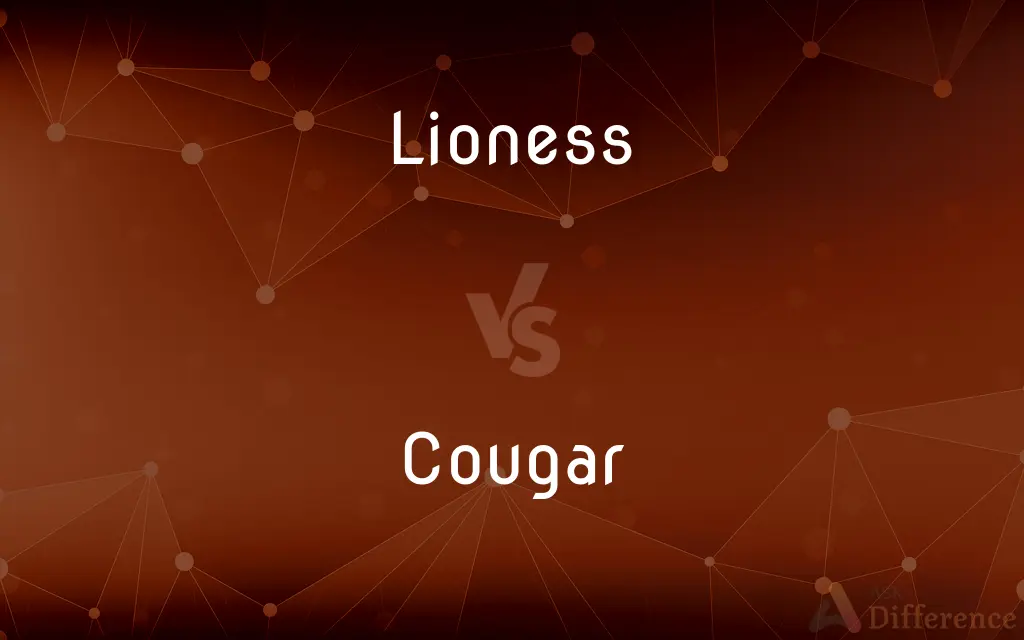Lioness vs. Cougar — What's the Difference?
Edited by Tayyaba Rehman — By Fiza Rafique — Updated on May 3, 2024
Lionesses are female lions, part of a social group and primarily found in Africa, while cougars are solitary and found in North and South America.

Difference Between Lioness and Cougar
Table of Contents
ADVERTISEMENT
Key Differences
Lionesses are known for their social behavior, living in prides that include other females and their offspring, while cougars, also known as mountain lions, are solitary animals except during mating or when mothers are raising their cubs.
In terms of habitat, lionesses are typically found across sub-Saharan Africa and are adapted to a variety of environments from grasslands to forests; cougars, however, have a wider range, extending from northern Canada to the Andes in South America.
Lionesses participate in cooperative hunting, which is crucial for their survival in the wild. This contrasts with cougars, who are ambush predators relying on stealth and strength to capture their prey alone.
Regarding diet, lionesses generally hunt large ungulates like zebras and wildebeests. Cougars are more versatile, consuming a diet ranging from insects and rodents to large ungulates depending on their local environment.
Reproductively, lionesses have a gestation period of about 110 days and can give birth to one to four cubs. Cougars have a similar gestation period but tend to have smaller litters, usually two or three cubs.
ADVERTISEMENT
Comparison Chart
Social Structure
Lives in prides with other females and cubs
Solitary, except during mating or with cubs
Habitat
Sub-Saharan Africa, diverse environments
North to South America, varied terrains
Hunting
Cooperative, hunts in groups
Solitary, ambush predator
Diet
Large ungulates (zebras, wildebeests)
Diverse (insects to large ungulates)
Reproduction
110 days gestation, 1-4 cubs per litter
90-96 days gestation, 2-3 cubs per litter
Compare with Definitions
Lioness
A female lion, known for living and hunting in groups.
The lioness led her pride in a hunt at dawn.
Cougar
A large, solitary feline also called a mountain lion or puma.
The cougar was spotted crossing the rocky terrain alone.
Lioness
Primarily found in sub-Saharan Africa.
The lioness roamed the vast savannah seeking shade.
Cougar
Not part of a social group, generally lives and hunts alone.
This cougar has been marking its territory to ward off competitors.
Lioness
Part of the social structure of prides which include females and cubs.
A lioness shares responsibilities for cub care within her pride.
Cougar
Habitat ranges from Canada to the Andes.
The cougar adapted well to the dense forested areas of the Andes.
Lioness
Dependent on large ungulates for food.
A lioness carefully stalked a zebra near the waterhole.
Cougar
Eats a varied diet from rodents to large mammals.
The cougar dragged the deer it had caught into the underbrush.
Lioness
Known for a gestation period of about 110 days.
The lioness secluded herself as she was nearing the end of her gestation period.
Cougar
Typically has two to three cubs per litter after a gestation period.
The cougar cubs stayed close to their mother in the den.
Lioness
A female lion.
Cougar
The cougar (Puma concolor) is a large cat of the subfamily Felinae. Native to the Americas, its range spans from the Canadian Yukon to the southern Andes in South America and is the most widespread of any large wild terrestrial mammal in the Western Hemisphere.
Lioness
A female lion animal.
Cougar
A large powerful wild cat (Puma concolor syn. Felis concolor) chiefly of mountainous regions of the Americas, having an unmarked tawny body and a long tail. Also called catamount, mountain cat, mountain lion, panther, puma; Also called regionally painter.
Lioness
A female lion famous person regarded with interest and curiosity.
Cougar
(Slang) A woman, especially one over 30, who romantically pursues or attracts younger men.
Lioness
A female visitor to a student at Oxford, especially during commemoration week.
Cougar
Puma concolor, a wild feline native to the Americas.
Florida panther
Lioness
A female lion.
Cougar
An American feline quadruped (Felis concolor), resembling the African panther in size and habits. Its color is tawny, without spots; hence writers often called it the American lion. Called also puma, panther, mountain lion, and catamount. See Puma.
Lioness
A female lion
Cougar
Large American feline resembling a lion
Common Curiosities
What kind of animals do lionesses primarily hunt?
They primarily hunt large ungulates like zebras and wildebeests.
What is the range of habitats for cougars?
Cougars can be found from northern Canada to the Andes in South America.
Where are lionesses mainly found?
They are primarily found in sub-Saharan Africa.
What is another name for a cougar?
Cougars are also known as mountain lions or pumas.
What is the diet of a cougar?
Cougars have a varied diet, from insects and rodents to large ungulates.
What type of hunting strategy do lionesses use?
Lionesses hunt cooperatively with their pride.
What is the gestation period of a lioness?
About 110 days.
Are cougars social animals?
No, cougars are solitary except during mating or when mothers are raising cubs.
What is the primary social structure of a lioness?
Lionesses live in prides that include other females and their cubs.
How many cubs does a cougar typically have?
A cougar typically has two to three cubs per litter.
Share Your Discovery

Previous Comparison
Primate vs. Mammal
Next Comparison
Cobweb vs. WebAuthor Spotlight
Written by
Fiza RafiqueFiza Rafique is a skilled content writer at AskDifference.com, where she meticulously refines and enhances written pieces. Drawing from her vast editorial expertise, Fiza ensures clarity, accuracy, and precision in every article. Passionate about language, she continually seeks to elevate the quality of content for readers worldwide.
Edited by
Tayyaba RehmanTayyaba Rehman is a distinguished writer, currently serving as a primary contributor to askdifference.com. As a researcher in semantics and etymology, Tayyaba's passion for the complexity of languages and their distinctions has found a perfect home on the platform. Tayyaba delves into the intricacies of language, distinguishing between commonly confused words and phrases, thereby providing clarity for readers worldwide.
















































